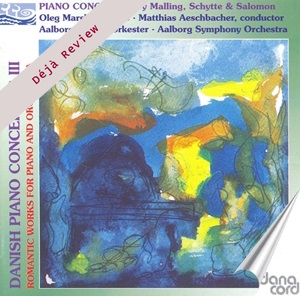
Déjà Review: this review was first published in October 2004 and the recording is still available.
Otto Malling (1848-1915)
Piano Concerto in C minor, Op 43 (1890)
Ludvig Schytte (1848-1909)
Piano Concerto in C-sharp minor, Op 28 (c.1884)
Siegfried Salomon (1885-1962)
Piano Concerto in A minor, Op 54 (1947)
Oleg Marshev (piano)
Aalborg Symphony Orchestra/Matthias Aeschbacher
rec. 2003, Aalborg, Denmark
Danacord DACOCD597 [76]
This is a resoundingly successful follow-up to the first two volumes in Danacord’s superb ‘Danish Piano Concertos’ series.
The Malling is a work of confident high-water romanticism in an idiom derived from the Schumann Concerto but with infusions from Brahms’ Second Concerto. The second movement is a superbly serene nocturne with a sincerely ingenuous Dvořákian lyricism. From here to the moonlight pastoral of a work like Schoeck’s Sommernacht is no great stride. The joyously tripping gopak of a finale storms along with Marshev firing on all twelve cylinders. Here, in addition to the derring-do which is the stock-in-trade of the Second Piano Concertos of Tchaikovsky and Saint-Saëns, Malling treats us to a lovely counter-melody.
Schytte‘s grand manner romanticism is also most distinctive. Like the Malling, there are suggestions of the influence of the Grieg Concerto both in the first movement and in the honeyed and suave Intermezzo. A pounding finale carries style elements from both Liszt and Tchaikovsky. Certainly not vapid display stuff; fully enjoyable.
While Malling also has a symphony to his name (let’s hear it please) and Schytte a lanky piano sonata in B-flat major, the much later Salomon has an extensive work-list. There are six string quartets, a wind quintet, concertos for violin (1916) and cello (1958), a cello sonata, two symphonies (1916 and 1920) and the travelogue orchestral suites Italia (1922) and Palestina (1924), not to mention the operas The Dove and the Snake (1925), Queen Dagmar (1928) and the most successful Leonora Christina (1926) which clocked up 79 performances over the fourteen years from 1928.
Salomon’s late-romantic style fitted him like a glove and he was not going to change it. His 1947 Piano Concerto stuck with determination to the Rachmaninovian idiom. The work’s opening gesture is pure Warsaw Concerto; grand romantic gestures are the order of the day. The middle movement is a contented soliloquy close at times to Dvořák. The finale is emphatically optimistic and the overall effect is likely to appeal to you if you enjoy the Moeran Rhapsody No. 3 (piano and orchestra), the Rozsa Spellbound Concerto and the Stanford Second Piano Concerto.
Marshev is fully the equal of the challenges of these three fine and neglected late and early romantic works.
The recording team have produced a manifestly pleasing sound-picture the delicacy of which can best be appreciated by hearing the silky Notturno from the Malling or the Lisztian bravura and tick-chaff strings in the finale of the Schytte.
Outstanding documentation as usual from Mogens Wenzel Andreasen. He holds, in relation to Danish music, the same affectionately respected position as Lewis Foreman in writing about the neglected musicians of the British musical renaissance.
Three fascinating romantic piano concertos. Maybe in its finale the Salomon does meander and revel in bombast, but the Malling and Schytte are enduringly and deeply enjoyable discoveries.
Rob Barnett
Help us financially by purchasing from




















